
Procedural
Requirements
Effective Date: September 07, 2016
Expiration Date: September 07, 2026

|
NASA Procedural Requirements |
NPR 9420.1A Effective Date: September 07, 2016 Expiration Date: September 07, 2026 |
| | TOC | ChangeLog | Preface | Chapter1 | Chapter2 | Chapter3 | Chapter4 | Chapter5 | Chapter6 | AppendixA | AppendixB | AppendixC | AppendixD | AppendixE | ALL | |
In the Budgeting Phase, NASA finalizes initial budget estimates and presents the request to OMB through the OMB Submit. OMB considers and finalizes the Agency's resource levels and typically provides additional programmatic requirements. The Agency updates budget plans to address OMB direction and coordinates performance plan revisions. OCFO provides final budget estimates to the Government-wide PBR and leads development of budget details and justifications in the CJ. The PBR and NASA CJ form the basis of Congressional deliberations on NASA appropriations. Guidance on submitting the budget can be found in OMB Circular A 11.
4.2.1 Purpose. The OMB Submit is an internal, pre-decisional product that conveys NASA's initial budget plan for the budget year in development and includes a proposed budget structure, the Program Financial Plan (PFP), and high-level budget information. The OMB Submit includes a series of detailed by-account requests and results in discussions between NASA leaders and OMB budget examiners. NASA's OMB Submit budget information is directly linked to the proposed annual performance plan developed and submitted to OMB in a separate, but parallel, process.
4.2.2 Process. OCFO develops Agency-level budget materials, supported by account and with organizational materials. Agency senior leaders and CAMs present budget requirements and justifications so OMB can make informed decisions as it considers NASA's plan and budget. When required, NASA responds to OMB requests for additional information. Refer to Figure 4-1, OMB Submit Process.
4.2.3 Timeline. The OMB Submit is traditionally due on the first Monday after Labor Day. This and other key dates are included in OMB Circular A-11.
4.2.4 Responsibilities.
4.2.4.1 OCFO BD leads development and presentation of OMB Submit materials. This includes providing CAMs with instructions on presentations and justifications, coordinating the overall timeline, and coordinating internal reviews. To facilitate discussions, OCFO BD realigns prior and current year budgets into a comparable structure and develops the PFP and budget tables. OCFO BD presents Agency-level information, including materials to support proposed budget strategies and impacts of alternatives. OCFO BD analysts support CAMs in developing account-level briefing materials.
4.2.4.2 CAMs finalize detailed budgets and present detailed budget materials to OMB. Justifications may include impacts of potential resource reductions and other analyses.
4.2.4.3 OCFO SID provides analyses and impacts of budget decisions and alternative positions.
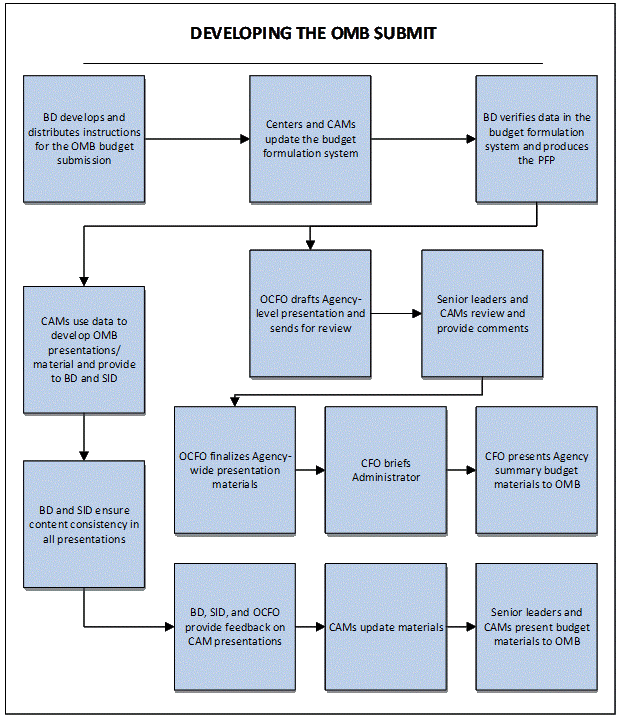
Figure 4-1, OMB Submit Process
4.3.1 Purpose. NASA's budget proposal is one part of the overall Federal budget proposed by the President. To facilitate OMB analysis and passback/settlement decision making, the Agency submits resource estimates using MAX A-11, a Government-wide database of budget schedule templates OMB uses to formulate the PBR. The Agency also responds to numerous data calls on cross-Government initiatives. These data calls may come through OMB Budget Data Requests, managers of eGovernment initiatives, or managers of cross-agency platforms or initiatives.
4.3.2 Process. OCFO follows requirements, per OMB Circular A-11, Part 2 and provides budget data in MAX A-11 or through other data collection tools. OMB compiles this data, which is later presented as a NASA "chapter" in the PBR, and the NASA data is included in cross-Government analyses of the budget. Refer to Figure 4-2, President's Budget Request, for the flow of information. Refer also to NPR 9330.1.
4.3.3 Timeline. OCFO BD typically begins data entry in late August and early September and updates information after settlement (usually early-to-mid December). NASA will review and make technical corrections after the official rollout of the PBR.
4.3.4 Responsibilities
4.3.4.1 OCFO BD provides required budget and financial actuals and estimates for the prior and current fiscal year and outyear estimates data in the MAX A-11 (or other) system. OCFO BD also works with DCFO for Appropriations, OGC, and CAMs to identify and propose appropriations language or corrections for the budget year.
Note: Typically, NASA provides financial data (e.g., obligations, outlays, and costing); estimated budget cross-cuts, as requested by OMB (e.g., R&D spending, spending by object class, and FTE); and other relevant information (e.g., proposed appropriations language for legislative initiatives). NASA initially enters budget and outyear data based on the OMB Submit and may use calculations based on historical trends. After settlement, the Agency updates the MAX A-11 system with adjustments to the prior estimates.
4.3.4.2 CAMs, Centers, OCFO SID, OCFO Financial Management Division (OCFO FMD), and OGC provide required data, narratives, and analyses to BD to support MAX A 11 requirements.
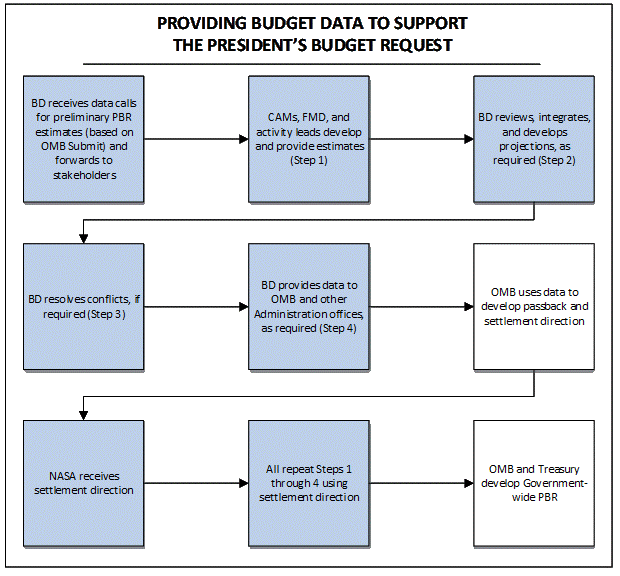
Figure 4-2, President's Budget Request
4.4.1 Purpose. Passback is an internal, pre-decisional product that provides the OMB response to NASA's OMB Submit. OMB provides budget guidance, establishes requirements for addressing cross-Government initiatives, specifies information for inclusion in the CJ, and typically provides programmatic direction. The settlement document provides post-appeal OMB guidance to which the Agency will comply.
Note: Settlement may include requirements for reports or other information for which the Agency is responsible.
4.4.2 Passback and settlement may also specify requirements for new reports or deliverables the Agency will provide to OMB.
4.4.3 Process. OMB budget examiners review the data in MAX A-11 and the OMB Submit. Examiners consider alignment to Administration priorities and develop an initial Government-wide budget. OMB develops and provides specific passback direction for each agency, including NASA, which includes guidance on the appeals process. NASA senior leaders evaluate passback and may choose to submit an appeal on one or more elements (often referred to as a reclama). To support the appeal, NASA provides justification materials and engages in discussion with OMB until OMB finalizes its budget guidance and programmatic decisions in the settlement. Refer to Figure 4-3, OMB Passback, Appeal, and Settlement Process.
4.4.4 Timeline. This iterative process begins with OMB review of the Agency OMB Submit, follows with passback (traditionally the Monday following Thanksgiving), and ends with OMB's settlement direction. After receiving passback, NASA usually has a 72-hour turnaround window to analyze the guidance and submit appeals and justification materials. It is not uncommon for OMB to conduct additional information gathering and analyses before issuing its settlement position. OMB's delivery of settlement can be delayed by events occurring in Congress or the Administration. NASA generally does not pursue the next phase of budget formulation without the OMB settlement.
4.4.5 Responsibilities
4.4.5.1 OCFO BD is the primary point of contact with OMB during passback, appeals, and settlement. This team receives, tracks, and coordinates responses to OMB requests for additional information. When appropriate, OCFO BD coordinates with senior leaders (and affected organizations) in preparing appeal letters and supporting information. OCFO BD also updates the budget formulation database with passback and final settlement controls.
Note: In the passback and settlement documents, OMB may establish requirements for reports or other documents. OCFO BD tracks the progress of a "passback deliverable" and ensures a timely response. Passback deliverables may be due at any time—they are not restricted to the passback/settlement timeframe.
4.4.5.2 CAMs provide responses, analyses, and justifications, as required.
4.4.5.3 OCFO SID reviews passback and provides analyses, responses, and other work, as required.
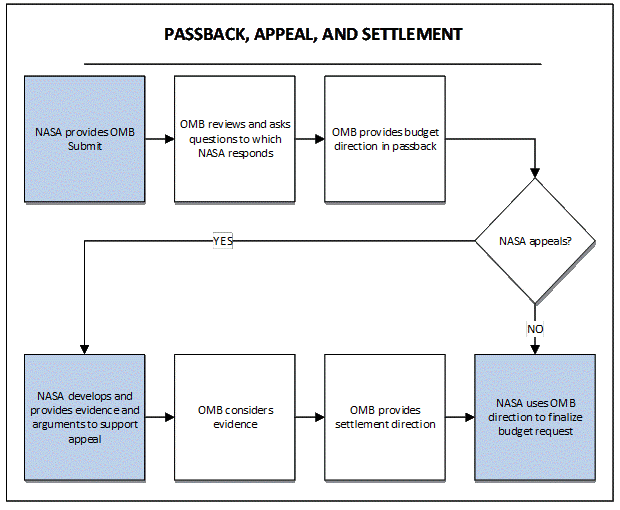
Figure 4-3, OMB Passback, Appeal, and Settlement Process
4.5.1 Purpose. The CJ provides detailed budget plans, justifications, and other information to support Congressional decision making on NASA appropriations.
4.5.2 Passback and settlement may also detail requirements for new reports or deliverables that the Agency will provide to OMB.
4.5.2 Process. NASA revises budget, updates PBR data entries, and develops the CJ. Refer to Figure 4-4, Congressional Budget Justification.
4.5.3 Timeline. NASA creates the final budget plan and finalizes justifications after settlement. NASA generally releases the CJ immediately after OMB releases the PBR, usually on the first Monday in February.
4.5.4 Responsibilities
4.5.4.1 OCFO BD leads development of the CJ and ensures compliance with requirements, such as: providing budget formats and instructions; reviewing CAM-provided justification materials; developing cross-cutting and supporting/supplemental materials; managing reviews, comments disposition, and concurrence; overseeing production; and managing the schedule. OCFO BD also updates MAX A-11 and other data collection systems with the final PBR budget figures used in the CJ.
Note: The CFO, DCFO for Appropriations, and Administrator (or designee) will determine the level of NASA response to each of the requirements outlined in OMB Circular A-11 and 51 U.S.C. § 30103. If in doubt, OCFO SID or OCFO BD will clarify requirements with the CFO and DCFOs.
4.5.4.2 OCFO SID reviews CAM budget justifications for alignment to strategic plan and goals and with NASA and Administration policies and strategic decisions. Within the CJ document, OCFO SID validates project cost and schedule data to ensure it is consistent with the MPAR requirements and other cost and schedule reports and provides any necessary management and performance narratives/summaries. In a separate process, OCFO SID finalizes budget-year performance plans and reports for concurrent release with the budget.
4.5.4.3 CAMs finalize account budgets and use budget formulation systems to redistribute requested resources to the program, projects, and Centers. Account, program, and project budget justifications are also developed and include narratives, schedules, results of evaluations, life-cycle costs, and other data.
4.5.4.4 Senior leaders and DCFO for Appropriations review and provide concurrence on CJ materials. The Administrator signs materials provided to Congress.
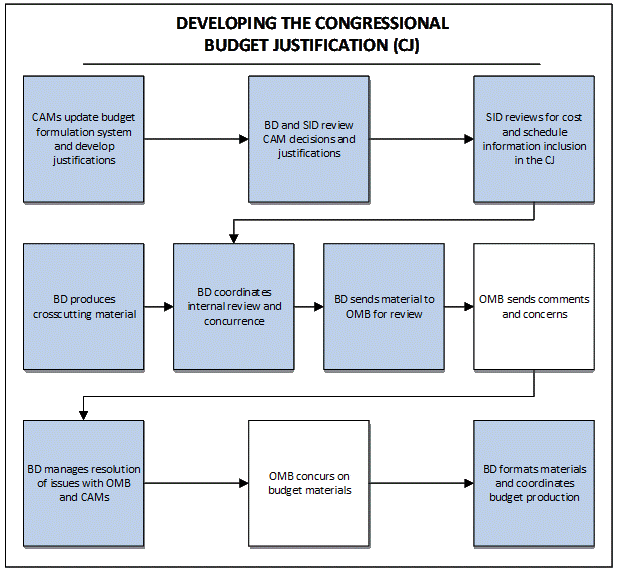
Figure 4-4, Congressional Budget Justification
Note: The CJ typically starts with an introductory letter from the Administrator. OCFO BD may work with Office of Communications on development of the letter. When required, OCFO BD or Office of Communications includes in the body of the letter material for which the Administrator is required to provide affirmation or signature (e.g., included performance reports).
4.6.1 Purpose. NASA coordinates the internal and external release of budget information. A coordinated rollout ensures consistency of message when providing budget materials and presentations to Congress, discussing issues with international partners, and briefing industry stakeholders, the media, and employees. Release of material should comply with guidance in OMB Circular A-11.
4.6.2 Process. Senior leadership coordinates a series of budget rollout meetings to ensure the Agency is both strategic and cohesive in how the budget is presented to Congress and to the public. Refer to Figure 4-5, Budget Rollout.
4.6.3 Timeline. Planning the budget rollout begins after settlement. Major activities occur when the PBR and CJ are released. Budget rollout continues for approximately two additional weeks as leaders support testimony and respond to inquiries.
4.6.4 Responsibilities.
4.6.4.1 Office of Communications coordinates internal budget rollout meetings and activities including finalizing key messages and communications strategies. Other Office of Communications rollout responsibilities include developing Administrator's speeches and presentations, organizing press conferences, and responding to media inquiries. The Office of Communications ensures final information is shared with the public via the NASA Web site.
4.6.4.2 OCFO coordinates development and review of budget rollout materials and Congressional briefings.
a. DCFO for Appropriations interfaces with Congressional committees by coordinating Agency briefings and defense of budget before Congress (e.g., testimony, hearing records, and responses to questions); reviewing and clearing materials for Congressional briefings, both at the Agency and account level; and providing budget materials.
b. OCFO BD prepares budget rollout materials, including briefings, fact sheets, and pre-formulated questions/responses, and manages review and concurrences. OCFO BD distributes the CJ within NASA and provides electronic versions to the Office of Communications for posting to NASA Web sites.
c. OCFO SID provides guidance, prepares performance-related rollout materials, and manages review and concurrences. OCFO SID distributes performance material within NASA and provides electronic versions to the Office of Communications for posting to NASA Web sites.
4.6.4.3 CAMs develop and coordinate review and concurrence of detailed by account or by mission briefings for Congressional briefings. CAMs also provide content for rollout materials.
4.6.4.4 Senior leaders conduct press conferences and provide briefings to the NASA community and external stakeholders, such as Federal and State, industry, international, and others.
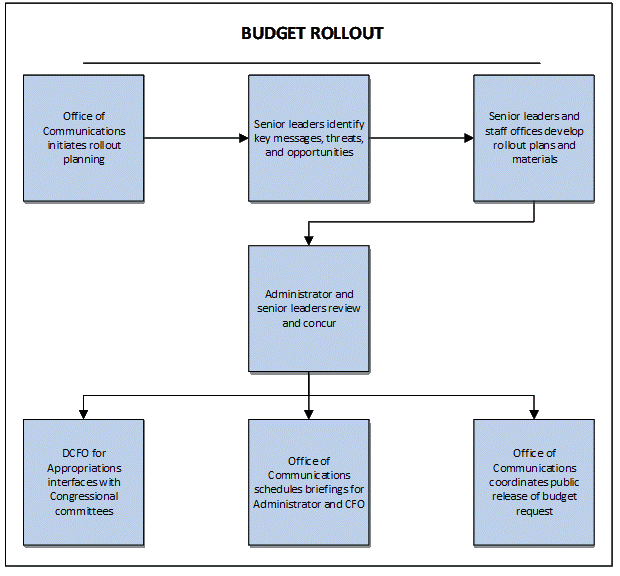
Figure 4-5, Budget Rollout
4.7.1 Purpose. An appropriation act authorizes NASA to incur obligations and make payments from the U.S. Treasury. After the PBR and CJ are released and during the appropriations process, NASA explains and defends its budget request. The Agency monitors progress of appropriation bills as Congress deliberates on the budget for the coming fiscal year.
4.7.2 Process. During consideration of appropriations requests, Congressional Committees and Subcommittees may request the NASA Administrator and other senior leaders to provide testimony about NASA's budget or Agency support for other national activities and priorities. Following NASA budget request hearings, Committees and Subcommittees typically send several "Question(s) for the Record" (QFRs), to which the Agency provides a formal response.
Note 1: If requested, NASA may provide input to OMB for a Statement of Administration Policy regarding pending authorization or appropriations legislation. OMB may choose to provide a statement to Congress when it appears the position of Congress appears to differ sharply from OMB direction to the Agency.
Note 2: If appropriations are not enacted prior to the start of the new fiscal year, the Agency plans for a CR. Without a CR or per OMB direction, OCFO plans emergency operations in the event of a lapse in appropriations. Refer to NPR 9470.1.
4.7.3 Timeline. The appropriations process begins with the release of the PBR. It concludes when Congress passes, and the President signs the appropriation bills into an Appropriation Act. Ideally, this occurs before the execution year starts on October 1, but is typically delayed.
4.7.4 Responsibilities
4.7.4.1 DCFO for Appropriations leads development and review of materials intended for Congressional audiences (e.g., testimony, responses to QFRs). The DCFO liaises with Congress and Committee staff to provide required information during budget deliberations.
4.7.4.2 OCFO, CAMs, and Centers provide input to materials for Congress, as required.
4.7.4.3 NASA Administrator and Senior leaders prepare and provide testimony to Congressional Subcommittees and Committees, as required.
| TOC | ChangeLog | Preface | Chapter1 | Chapter2 | Chapter3 | Chapter4 | Chapter5 | Chapter6 | AppendixA | AppendixB | AppendixC | AppendixD | AppendixE | ALL | |
| | NODIS Library | Financial Management(9000s) | Search | |
This document does not bind the public, except as authorized by law or as incorporated into a contract. This document is uncontrolled when printed. Check the NASA Online Directives Information System (NODIS) Library to verify that this is the correct version before use: https://nodis3.gsfc.nasa.gov.